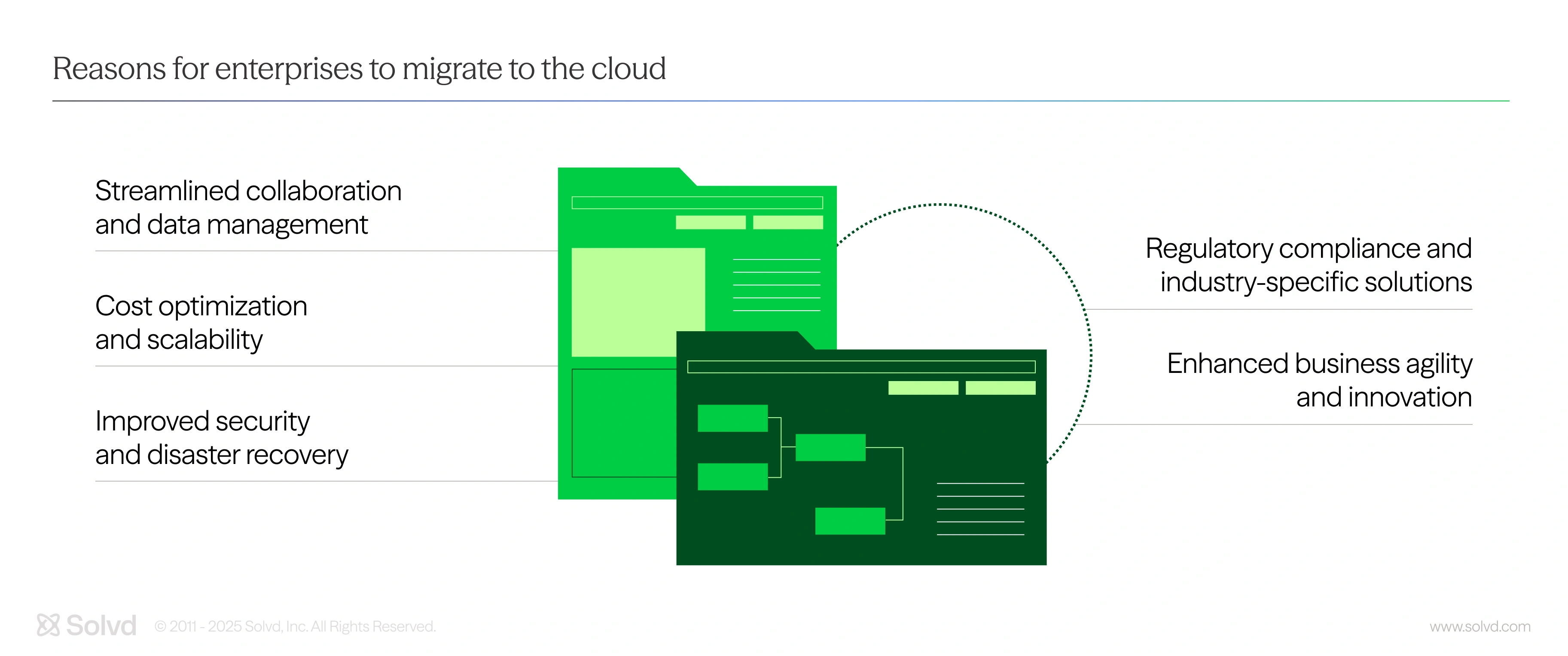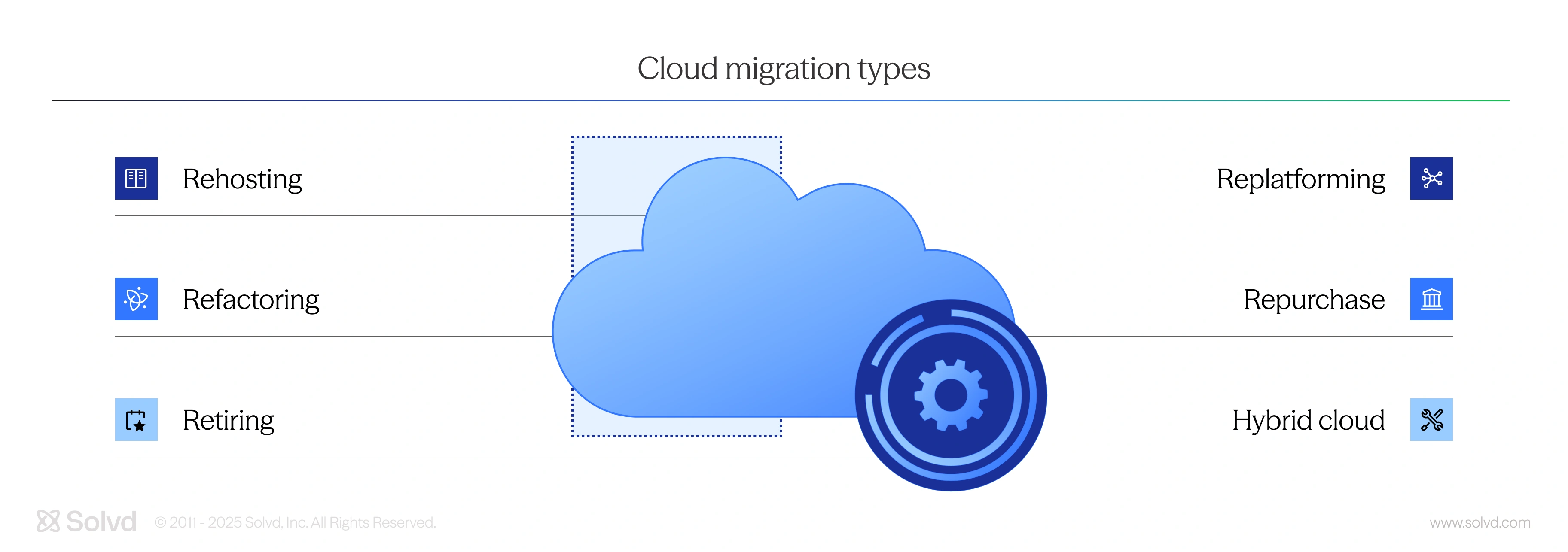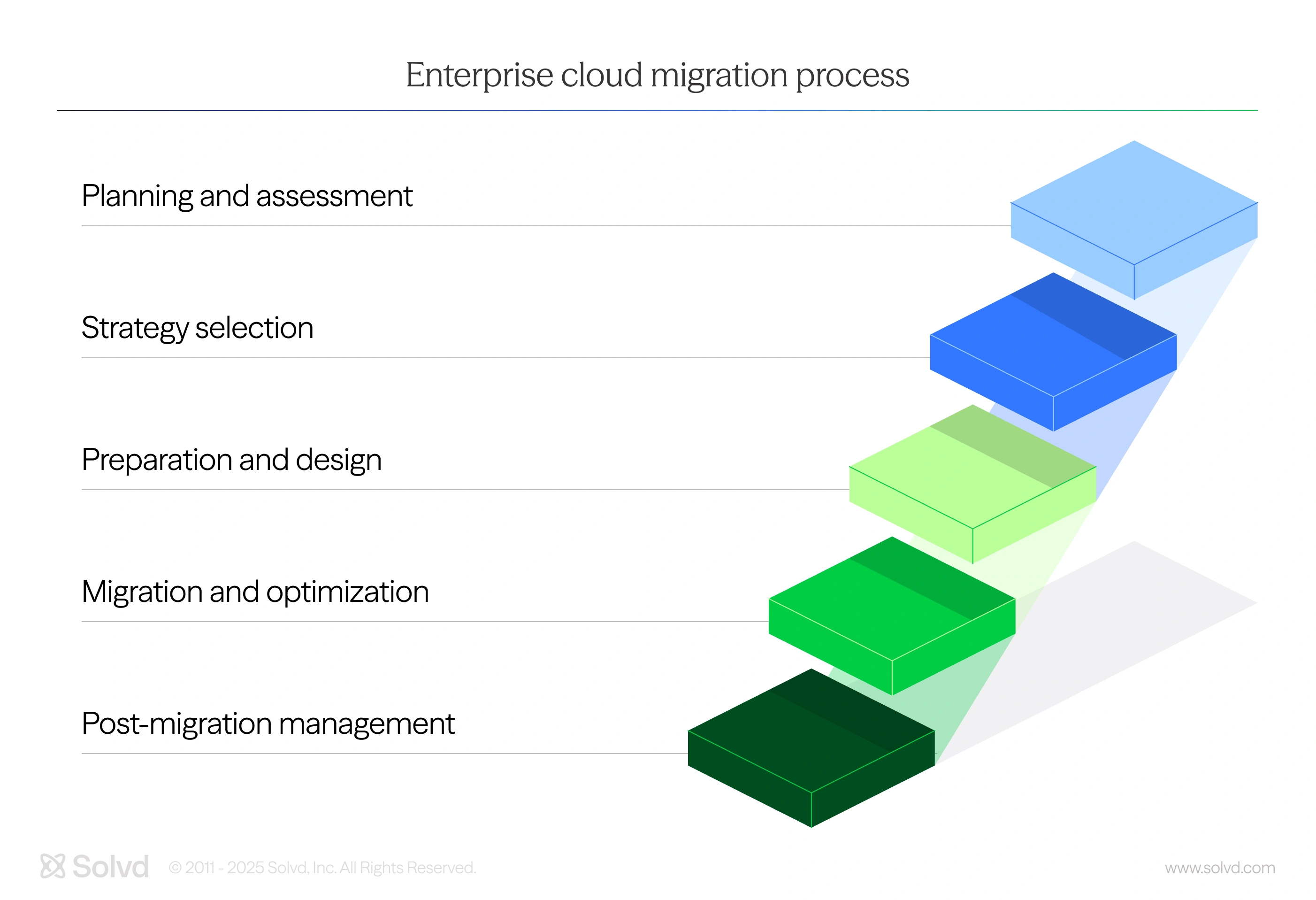Have you ever felt like your current IT infrastructure is holding your company back?
Imagine being nimble and adaptable, that’s the power of the cloud! Enterprise cloud migration lets your company move data, applications, and IT operations all to a super-powered online system. It’s like a magic upgrade – you’ll enable stronger security, smoother workflows, and even cost savings! Feeling unsure about how to make the switch? This article is your guide that cuts through all of the confusion and it will give you a clear roadmap for this exciting journey to the cloud!
What is enterprise cloud migration?
Enterprise cloud migration refers to the process of shifting a company’s digital assets, applications, data, and IT infrastructure from on-premise servers to a cloud environment.
Imagine a large retail chain that has hundreds of stores. Their point-of-sale systems, customer data, and inventory management software might all be running on physical servers at their headquarters. An enterprise cloud migration would involve moving these systems and data to a cloud provider. This would allow the company to access its IT resources from anywhere through an internet connection, which improves scalability and potentially reduces costs.
Enterprise cloud migration isn’t merely a one-size-fits-all approach. Companies can choose to migrate their entire IT infrastructure all at once or they can take a more gradual approach by moving specific applications or data sets first. The ultimate decision depends on the organization’s needs, resources, and risk tolerance.
Reasons for enterprises to migrate to the cloud
Many businesses are hesitant to move to the cloud, because they are worried about security or they are unsure of the financial benefits. But the stats tell a different story.
- 94% of enterprises believe the cloud is more secure than on-premise solutions
- 60% of respondents to a survey reported that cloud capabilities increased or sustained revenue within the last year
- The global cloud computing market is projected to reach $791.48 billion by 2028
Let’s delve into the key reasons why enterprises are embracing cloud migration.

Cost optimization and scalability
Maintaining an on-premise IT infrastructure can be a significant financial burden for enterprises. Hardware needs to be purchased and maintained, software licenses require constant renewal, and a skilled IT staff is needed to manage it all. Enterprise cloud migration offers a pay-as-you-go model. It’s a model where companies pay only for the resources they use. This eliminates the need for an upfront capital expenditure and it allows for flexible scaling that’s based on the business’s individual needs.
For example, an e-commerce company might experience spikes in traffic during the holiday season. With an on-premise infrastructure, they would need to have enough server capacity to handle these peaks, even though the required resources would be the same for most of the rest of the year. Companies that migrate to the cloud can easily scale their resources up during peak periods and down during slower times, which leads to significant cost savings.
Enhanced business agility and innovation
The cloud provides enterprises access to a vast array of on-demand computing resources, including storage, processing power, and software applications. This leads to faster development cycles, easier deployment of new applications, and a quicker time to market for new products and services.
Imagine a large healthcare provider that’s looking to develop a new app for patient appointment scheduling. If they use on-premise infrastructure, the development team will be limited by the hardware and software resources currently available internally. However, by leveraging the cloud, the team can quickly provision the necessary resources, develop and test the app, and deploy it to patients in a much shorter timeframe.
Improved security and disaster recovery
Cloud providers invest heavily in security measures in order to protect their data centers and infrastructure. This investment includes physical security, access controls, and sophisticated threat detection systems. Enterprise cloud migration allows companies to benefit from these advanced security measures without having to invest in it all by themselves.
Furthermore, cloud providers offer robust disaster recovery solutions. In the event of a natural disaster or hardware failure, a company’s data and applications can be restored quickly from a geographically dispersed backup location. This minimizes downtime and it ensures business continuity.
Let’s imagine that a global marketing agency has migrated to the cloud previously and faces a natural disaster that disrupts its local office. Thanks to their previously migrating to the cloud, employees from the unaffected regions can still access their essential marketing tools and client data because they migrated. This risk mitigation helps ensure the business’s continuity.
Streamlined collaboration and data management
The cloud facilitates seamless collaboration between employees, teams, and even external partners, all regardless of their physical location. Cloud-based applications allow for real-time document sharing, project management, and communication. These capabilities help foster improved teamwork and productivity.
Additionally, cloud storage solutions offer centralized access to data, which makes it easier for authorized personnel across the organization to access and analyze the information they need. This leads to better decision-making and improved business insights.
Imagine a marketing team who is working on a new advertising campaign. Traditionally, they might have to email drafts back and forth, all with different versions that are scattered across individual computers. With cloud-based collaboration tools, the team can now all work on a single document in real-time. Everyone on the project will be able to see the latest updates, leave comments, and they can even suggest edits simultaneously. This eliminates a lot of confusion and version control issues that are associated with working with individual and unconnected computers.
Regulatory compliance and industry-specific solutions
Many industries, such as finance and healthcare, have strict regulations regarding data privacy and security. Cloud providers offer solutions that are specifically designed to meet these strict compliance requirements. This can reduce the burden on enterprise IT teams and it ensures that the company is adhering to all of the relevant regulations.
Furthermore, some cloud providers offer industry-specific solutions that cater to the unique needs of particular sectors. For instance, a cloud platform might offer pre-built solutions for financial data analysis or medical record management. These solutions allow enterprises to leverage specialized tools without the need to develop them from the ground up.
The 6 main types of cloud migration strategies

Rehosting (lift and shift): the simple move
Imagine lifting a physical server and placing it on a virtual shelf in the cloud. That’s the essence of rehosting, which is also known as “lift and shift.” This is the most straightforward approach, it’s where applications are migrated “as-is” to the cloud environment- all with minimal modifications.
Example: A company running an e-commerce website currently on its own servers might choose to rehost the website on a cloud platform like Amazon Web Services (AWS). This allows them to leverage the scalability of the cloud in order to handle spikes in traffic during sales events. It gets done without the need to invest in additional physical servers.
Pros
- Fast and easy to implement.
- Minimizes application downtime.
- Cost-effective for applications that have a low dependency on specific hardware configurations.
Cons
- May not optimize cloud benefits such as scalability and elasticity.
- Existing inefficiencies in on-premises applications might transfer over to the cloud.
Replatforming: lift, shift, and improve
Replatforming builds upon rehosting by taking advantage of the inherent functionalities of the cloud platform. Here, applications are migrated with some modifications in order to benefit from cloud-native features like autoscaling and containerization.
Example: A company that’s using a traditional database management system on-premises could migrate it to a managed database service that’s offered by their cloud provider. This would free up IT resources for other tasks while leveraging the built-in security and scalability of the managed service.
Pros
- Improves performance and efficiency compared to rehosting.
- Reduces management overhead for IT teams.
- Enables some level of cloud-specific optimization.
Cons
- Requires more effort and expertise compared to rehosting.
- Might involve code changes or configuration adjustments.
Refactoring: rebuilding for the cloud
Refactoring is a more transformative approach where applications are completely rewritten in order to take full advantage of the cloud architecture. This involves breaking down monolithic applications into smaller microservices which are easier to manage and scale independently.
Example: A financial services company that has a complex legacy application could choose to refactor it into a cloud-native microservices architecture. This would allow for faster development cycles, improved reliability, and easier integration with other cloud services.
Pros
- Maximizes the benefits of cloud-based scalability and agility.
- Enables modern development practices and continuous integration/continuous delivery (CI/CD).
- Improves application performance and fault tolerance
Cons
- The most time-consuming and resource-intensive migration strategy.
- Requires significant development expertise and there is potential for having to rewrite the application completely.
Repurchase: replacing the old with the new
In some cases, migrating existing applications to the cloud might not be the most efficient approach. Repurchase involves replacing on-premises software with cloud-based Software-as-a-Service (SaaS) offerings. These pre-built applications can often provide faster deployment, lower maintenance costs, and automatic updates.
Example: A company using an on-premises customer relationship management (CRM) system could consider switching to a cloud-based SaaS CRM solution. This would eliminate the need to manage servers and software licenses, and it allows them to focus more on their core business activities.
Pros
- Quick and easy to implement, often with minimal disruption.
- Reduces IT management overhead significantly.
- Provides access to regularly updated features and functionality.
Cons
- Might not offer the same level of customization as on-premises software.
- Vendor lock-in can be a concern for businesses that rely heavily on specific features.
Retiring: decluttering the digital landscape
Not everything needs to move to the cloud. The migration process is an excellent opportunity to evaluate existing applications and for identifying those that are no longer required. Retiring means decommissioning outdated and unused applications. It streamlines the IT landscape and it reduces costs.
Example: A company might discover during the migration process that an old internal communication application is no longer actively used. Retiring this application will free up resources and improve overall IT efficiency.
Pros
- Reduces unnecessary software licenses and maintenance costs.
- Simplifies IT infrastructure and improves security posture.
- Allows for focusing resources on critical applications.
Cons
- Requires careful analysis and planning to avoid decommissioning essential applications.
Hybrid cloud: the best of both worlds
Many businesses opt for a hybrid cloud approach which combines on-premises infrastructure with public cloud resources. This strategy allows for more flexibility and control by keeping sensitive data and/or applications on-premises while leveraging the scalability and cost-efficiency of the cloud for other workloads.
Example: A healthcare provider might choose to store patient data on secure on-premises servers but migrate its administrative applications, like billing and scheduling, to the cloud. This ensures compliance with data privacy regulations while offering improved accessibility and cost savings for non-sensitive functionalities.
Pros
- Provides flexibility to tailor the cloud strategy to specific business needs.
- Maintains control over sensitive data and applications.
- Enables leveraging the benefits of both on-premises and cloud infrastructure.
Cons
- Requires more complex management due to the hybrid environment.
- Security considerations need to be addressed across both on-premises and cloud deployments.
Choosing the right enterprise cloud migration strategy depends on your specific business needs, resources, and application landscape. Carefully evaluate factors like cost, security, performance, and long-term goals before you embark on your cloud journey. By understanding the different migration types and their pros and cons, you can make informed decisions to leverage the power of the cloud and unlock new opportunities for your business.
Enterprise cloud migration process
Migrating an entire enterprise to the cloud isn’t merely a one-click operation. It’s a strategic journey that has well-defined phases. Here’s a simplified look at the key steps involved.

- Planning and assessment. This crucial initial stage involves understanding your current IT infrastructure, applications, and data landscape. Analyze what needs to move to the cloud, and prioritize it based on your business goals and technical feasibility.
- Strategy selection. Based on your assessment, choose the most suitable migration strategy (rehost, replatform, etc.). Consider factors like cost, existing skill sets, and the desired level of cloud optimization.
- Preparation and design. This phase involves detailed planning for the migration itself. Design the cloud environment, configure security settings, and conduct thorough testing in order to ensure a smooth transition.
- Migration and optimization. Execute the migration plan by transferring data and applications to the cloud environment. Monitor performance closely and optimize configurations for maximum efficiency.
- Post-migration management. The journey continues after the migration. Continuously monitor and manage your cloud environment for ensuring security, performance, and ongoing cost optimization. This might involve integrating cloud-native tools and automation for improved efficiency.
Remember, cloud migration is an ongoing process. By adopting a strategic approach and following a well-defined plan, enterprises can navigate the journey successfully while unlocking the full potential of the cloud.
Conclusion
Embarking on your enterprise cloud migration might seem like a daunting task, but it can be a smooth and rewarding journey by having the right strategy along with careful planning. Remember, even the most prominent tech giants started somewhere, and with the right tools and guidance, you can conquer the cloud and reach new heights of efficiency and agility.
Navigating the complexities of enterprise cloud migration doesn’t have to be a solo expedition however. For those seeking expert guidance and support throughout the process, consider partnering with us here at Solvd. We are a reliable and trusted cloud managed services provider. Let us at Solvd help you navigate the technical terrain and ensure a successful climb all the way to the summit.









